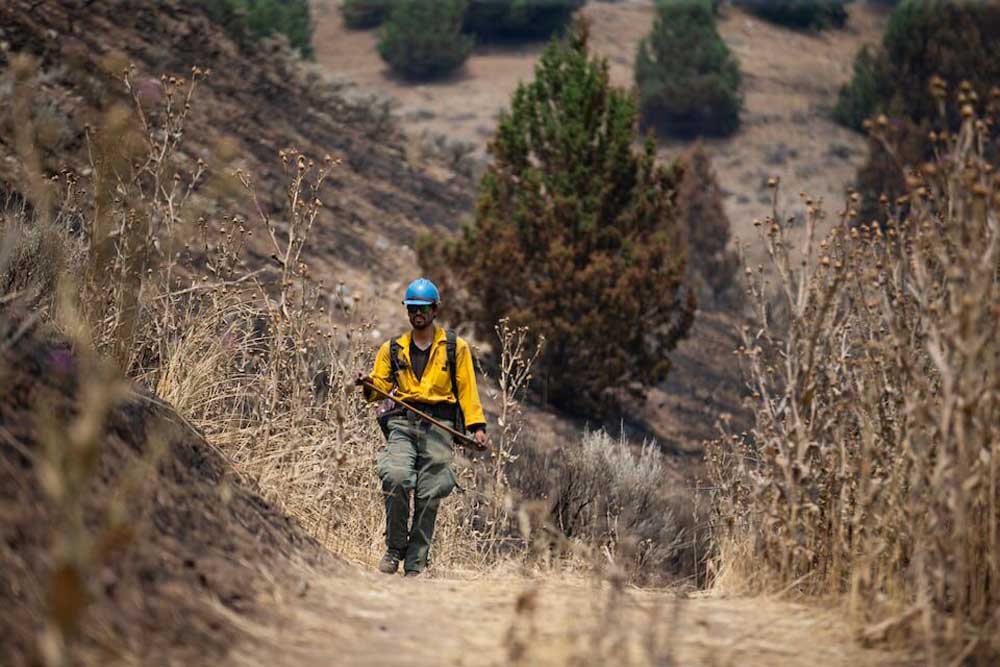When wildfires spark in Oregon, volunteers often begin what the hotshots finish
Published 1:42 pm Thursday, August 1, 2024

- A firefighter walks along a dirt road in the Lookout Mountain region in Eastern Oregon near Durkee on Sunday.
DURKEE — Rancher Levi Bunch nodded at the portable firefighting pump standing at the ready to douse embers as a crew of hotshots dug smoldering roots out of the ground.
Bunch wished he’d had the pump days before when he and other volunteer firefighters had tried for days to stamp out part of the Thompson Fire on their own.
Every day since the flames reached this corner of the family rangeland near the Idaho border in Baker County, he and others fighting the fire had asked federal officials for a real firefighting pump.
They needed something that could deploy much more water at much higher pressure than the dinky Honda-motor pump that Bunch’s brother-in-law was using to extinguish the encroaching flames.
The Mark-3 Portable High-Pressure Fire Pump arrived three days later from the fire’s incident command.
“It’s just kind of the way the wheels turn sometimes,” Bunch said.
Amid historic wildfires that have stretched resources thin nationwide, Oregon communities have relied on local volunteer associations to jump on fires before they turn into conflagrations.
Called Rangeland Fire Protection Associations, they are comprised primarily of ranchers with a vested interest in stopping fires — the flames can engulf their livelihoods, the grass their cattle would otherwise graze into the fall.
The Thompson Fire, part of the 54,615-acre Badland Complex of six fires to the east of Interstate 84 near Durkee, is one of 35 large fires continuing to burn Oregon. The Badland fires began July 22 with a lightning strike and are now being fought by 296 workers and 25 engines, bulldozers and other large firefighting equipment.
Across Oregon, about 1.16 million acres have burned so far this year, according to the Northwest Interagency Coordination Center. The nearly 294,000-acre Durkee fire, to the west of I-84, was at one point the largest wildfire in the U.S.
Nearly 9,600 firefighters and support workers are fighting wildfires in Oregon, more than a third of the approximately 27,100 deployed nationwide.
The numbers don’t include volunteers from Oregon’s 28 rangeland associations — not-for-profits overseen by the Oregon Department of Forestry. The associations get training and grants through the department and usually have a yearly budget no more than $10,000 each, said Department of Forestry spokesperson Jessica Neujahr.
The associations can be critical to catching wildfires before they grow into something unmanageable, Neujahr said, because the volunteers might be able to get to a fire much more quickly than the professionals.
Bunch’s Burnt River Rangeland Fire Protection Association was one of the first groups of firefighters to tackle multiple fires in Eastern Oregon, including the Thompson and Durkee fires, Neujahr said. Other fire protection associations helped fight the Falls Fire, she said, and helped drive cattle off private and federal grazing land to safety.
The incident command team tackling the Badland Complex has found the Burnt River association’s work to be invaluable, said Badland spokesperson Stephanie Cooke.
“Our success is directly related to the (association) making a great start,” Cooke said in an email.
“We continue to partner with them in the field, and their work has been extremely helpful as we implement our strategy,” she said.
The Thompson Fire is now 20% contained with help from the hotshot crew and others from around the country.
Nearly half of the grazing land that belongs to Bunch and his extended family — adding up to about a thousand acres — has burned.
It is speckled with evidence of its history. The dirt roads winding through it pass a burned-out 1930s-era car with a tree growing through its frame. Not far is a caved-in root cellar made of stacked stones.
Much further down the road is a leaning cabin that Bunch’s grandmother, in her 90s, said has been there as long as she can remember.
Now, the High Desert expanse is covered with the black, spindly remains of burned sagebrush and charred ground. Smoke rises from some stumps that are still standing and from inside the still-hot holes left from stumps that have all but burned out.
Bunch, 37, had been helping fight the Durkee Fire when he switched to the Thompson Fire threatening the family grazing land soon after it ignited last week.
Two days later, Bunch, his brother-in-law Kyle Henrikson, 41, and about a dozen friends and neighbors used two bulldozers to plow the road winding along Sisley Creek, which flows through the grazing land.
They created a stretch of dirt they hoped was wide enough to stop the flames from crossing the road and igniting grass and trees.
If the flames did cross the road, they could start climbing up a hill toward where a herd of several hundred of the Bunch and Henrikson family’s cattle were grazing.
But the fire jumped the road farther up the creek and started to spread. Given the strong winds that day, the volunteers were afraid that the Durkee Fire could jump the interstate and start coming toward them from the other side, potentially pinning them between two fires. They decided it was safer to leave, Henrikson said.
Henrikson came back in the morning by himself and saw that the Thompson Fire had burned swaths of grass and destroyed a homestead cabin on the property that went back to Oregon Trail times when the family moved to the spot.
Henrikson pulled out his satellite phone and sent his wife a text message to call for help. Within an hour, Bunch and other volunteers were back on scene.
Henrikson plowed the ground with a bulldozer, creating new lines of dirt to prevent the fire from spreading further, while others sprayed down flames and hotspots with water from water bladders hanging on their backs.
Then, professional firefighters joined them and backed up their work by putting out hotspots, Henrikson said. They brought a larger bulldozer and used it to widen the dirt road the volunteers had been working on.
That night, Henrikson slept in his truck near where they’d been working, confident he was safe because the professional crews were on-site.
An interagency hotshot crew, elite firefighting crews known for their skill, experience and tenacity, soon arrived as well, Henrikson said.
The following morning — last Friday — Bunch and Henrikson saw smoke rising farther up the creek than where they had been previously working. The two ranchers followed the road to find a lone firefighter battling flames climbing up the trunk of a tree.
The three men quickly joined forces.
Henrikson set up his Honda water pump to draw water from the creek and pump it out of a 130-foot hose while the firefighter called in a helicopter to dump water on the flames and smoldering roots. The helicopter made multiple runs, with time between each run for Bunch to dig at the smoldering roots while Henrikson doused them with creek water.
There was another flare-up Saturday, but the hotshots managed to put it out, with more help from a helicopter, Henrikson said.
By the end of the day, the fire was sufficiently under control that Henrikson took on the job of shuttling the professional firefighters from the front line to the makeshift “parking lot” in the dirt several miles away.
This past Sunday, Bunch and Henrikson stood near the glistening red pump, down a hill from the hotshots cutting branches and pulling out smoking stumps.
One of them stopped to chat with the two men, leaning on the firefighting hoe in his hands.
His face and clothes were covered in dirt and grime.
He said his crew was working to ensure the fire wouldn’t start again from any embers still burning.
Bunch said he was ready to help the second they needed.
He’d primed the pump and took the hose up the hill and filled it with water from Sisley Creek.
“It’s ready,” Bunch said. “As soon as I start to pump, they’ll have water.”








